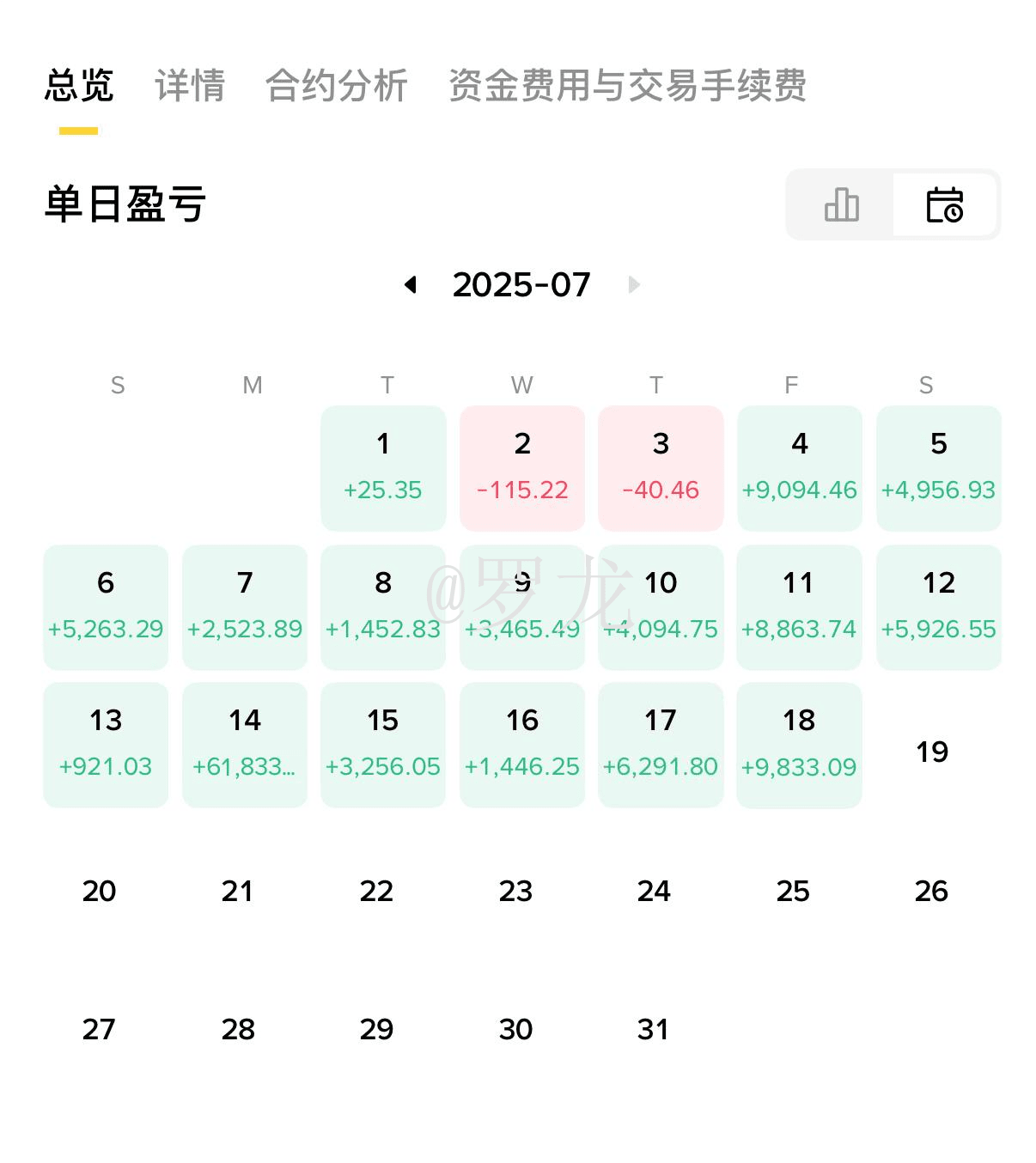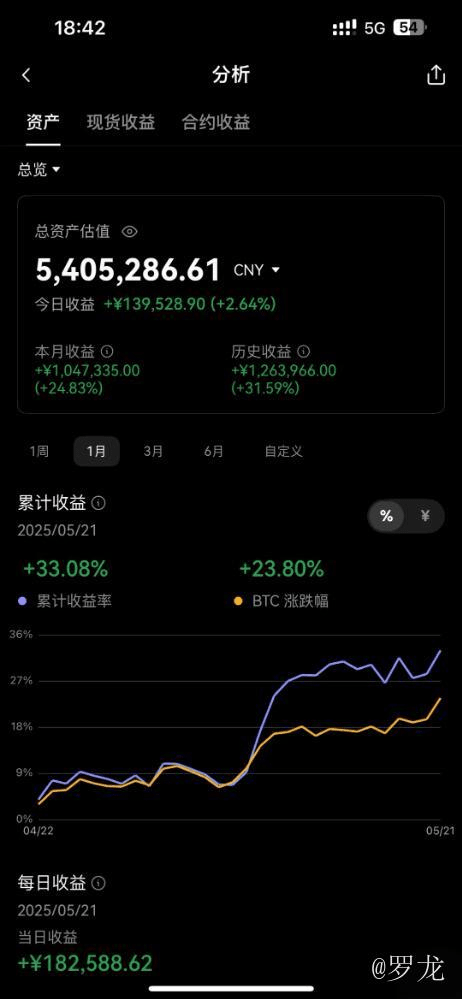
After ten years of trading in the cryptocurrency circle, I have personally experienced three bull-bear transitions, from an initial principal of 50,000 to achieving financial freedom today.
During my 6 years as a professional trader, I have had ups and downs, from debt to financial freedom, a leap in class. During this time, I have earned, lost, traded various tokens, ICOs, and mining, and have encountered countless pitfalls. It is said to be a game of long and short, but it feels more like managing one's mindset, filled with surprises and disappointments, a magical circle, an enchanting place, I have summarized numerous operational methods and strategies, ultimately, the only way to make money is simple and brutal: buy in a bear market, sell in a bull market, and profit without fail.
Core Survival Law
Only use money you can afford to lose.
Wait for the right opportunity like a cheetah.
5x leverage is the golden ratio.
Keeping the principal is keeping hope.
Core strategy: high leverage + precise targeting + strict stop loss.
1. Only trade BTC/ETH - high liquidity, few spikes, the battlefield for large funds is your opportunity.
2. Start with 20x leverage - turning 1000U into 20,000U requires just a 5% fluctuation. But remember: set a stop loss as soon as you open a position; the liquidation line is your bottom line.
3. Breakthrough Follow-up Method - wait for significant horizontal consolidation breakthroughs (over 4 hours), enter the moment the price breaks previous highs/lows, catching the momentum.
In the core of cryptocurrency trading, only those educated by the market will understand.
The core of trading is position management:
All trading activities must be conducted within appropriate position management.
Big gains at the right time.
When losing, lose small.
This is a guarantee for stable capital growth.
Because people are always emotionally driven to make rational decisions.
No matter how rational you claim your decisions are,
It is certainly driven by emotion.
Your direction is influenced by your subjective assumptions.
All technical indicators will show strong or weak tendencies based on your judgments.
We made money in the market.
We should be grateful to the market.
It’s not that we are inherently strong.
But it's because the market has made us taste the sweetness.
Everything is about opportunity and discipline leading us to victory.
The key here is position management.
Living longer increases the chances of winning.
This is a probability game.
Not anyone's ATM.
The difference between speculation and gambling is the difference between discipline and animal instinct.

The violent rolling technique of turning 1000U into 20,000U: the ultimate method for small funds to turn around with three principles of position control.
Initial position of 200U to test the waters - don’t go all in right away, leave enough bullets.
Withdraw the principal immediately after making 300U - continue playing with the market's money.
Step-by-step profit harvesting - earn 30%, first take 1/3 off the table, then strike back after breaking the previous high.
(My 'Pyramid Positioning Method' can reduce the risk of liquidation by 80%)
The devil is in the details.
Strike during the golden period: keep an eye on the high liquidity peak of the US market (9 PM - 12 AM).
Lock leverage at 3-5 times - no matter how tempted, don’t cross the line.
Move stop loss at 0.5% - this is your lifeline.
(Last year, I used this method on PEPE to achieve 7 times the return in 18 days.)
Mindset determines everything.
Account up to 3000U? Withdraw 1000U to secure profits! Remember:
The scariest thing in a bull market is not missing out on opportunities, but watching profits slip through your fingers.
Want to turn around with small funds?
It's not about luck, but about this set of rolling techniques!
While others are still hesitating, you have already rolled profits into a snowball...
99% of those eager to profit in the cryptocurrency circle typically go through three stages.
The first stage is a journey of experience, often resulting in small gains followed by large losses, or profits being entirely given back.
The second stage is to solidify beliefs, gain small profits, summarize experiences after encountering new things, and then form one's own rhythm.
The third stage is the moment that can truly change one's fate; with strategy, timing, discipline, and a bit of luck, substantial wealth might be earned.
Those who can leave with full loads in the first stage and retire successfully are rare; more people exhaust their capital and cannot reach the shores of success. Just being able to stay at the 'table' is already quite remarkable.
In summary, during the upward cycle, everything seems wonderful; during the downward cycle, everything appears terrible.
Therefore, when information floods in like a tide, one should maintain humility and caution.
The more eager one is to operate, the more they often lose. Strive to cultivate a good mindset, excellent discernment, and a high level of focus!

What is the almost 100% profitable dumb way to make 20 million? These are the 7 iron rules I earned with blood and tears.
I finally realized - the dumbest methods often make the most money. Today, I’ll show you my trading diary:
1. Night Battle Rule.
Daytime trading is like a drunken man dancing, with messages flying around, and market makers drawing lines. I only open my trading software after 9 PM every day, when the candlesticks have cleared up, and the direction is clear.
2. Withdraw to avoid getting too invested.
Earned 1000U? Withdraw 300 to your bank card first. I have seen too many people go from earning three times to zero, just a difference of 'wait a bit more.'
3. Three Indicator Set
MACD Golden Cross and Death Cross
RSI overbought and oversold.
Direction of the Bollinger Bands opening.
Only three indicators with two resonances can trigger action; this is a lesson learned at the cost of 200,000.
4. The Art of Moving Stop Loss
When monitoring, raise the stop loss by 3% every time it rises by 5%, and always set a 3% hard stop loss before sleeping. Last year's 312 crash left my account unharmed thanks to this method.
5. Friday Withdrawal Day
Every Friday, I reliably withdraw 30% profit; the rest is the battlefield capital. After 8 years, the interest from withdrawals alone is enough to buy a house.
6. Candlestick Time and Space Law
For short-term trading, look at 1 hour: only consider after two consecutive bullish candles.
Looking at the horizontal market for 4 hours: ambush near support levels.
Remember: the market is three-dimensional; don’t use two-dimensional vision to look at candlesticks.
7. Four Blood Oaths
❗ Leverage above 10 times = suicide.
❗ Touching altcoins = giving money to the market makers.
❗ More than 3 trades a day = signs of losing control.
❗ Borrowing money to trade cryptocurrencies = a path to no return.

Seven ways to die in cryptocurrency trading! Be vigilant in a bull market!
The cryptocurrency bubble has confused countless people, leading them to invest without hesitation. Some even choose to resign and invest all their assets into the wave of trading, then record their trading diaries online.
It is certain that those who start trading cryptocurrencies usually find it easy to make profits, and this quick money feeling makes it hard to resist, further igniting their greed and hoping to earn more wealth. However, even if the cryptocurrency bubble does not burst, speculators still face a significant risk of losses. Next, let's take a look at the seven most common 'ways to die' for traders!
First type: Died from catching the bottom against the trend.
The sharp drop in cryptocurrency prices often becomes a touchstone for the greedy mentality of traders. Some traders are overjoyed to see the market decline and impatiently choose to catch the bottom against the trend, but they fail to realize that the so-called bottom is not the end, but a bottomless pit.
The bottom of this pit may hide more uncertainties and risks, like an abyss; once fallen in, bottom catchers may find themselves in endless dilemmas, buying in again and again, repeatedly getting trapped.
It can be said that catching the bottom against the trend is one of the main reasons many traders incur losses. In a clearly declining market, some traders mistakenly believe that cryptocurrency prices have dropped low enough to attract new speculators, and thus a rebound should be imminent.
However, the reality is often that the more one tries to catch the bottom, the more they lose, until they are overwhelmed, not only losing the profits made earlier but also potentially exhausting the principal.
Taking the volatility of Bitcoin in 2013 as an example, it soared from a few dollars to about $1000, then plummeted to over $100. This roller coaster market led countless traders to bankruptcy.
The strategy of catching the bottom can only succeed in a fluctuating or recovering market, and at other times, such behavior is usually a shortcut to a dead end. This is the importance of trend-following operations we often talk about; correct trend-following operations can succeed multiple times in fluctuations, while counter-trend operations, even if done correctly countless times, once done incorrectly may face irreparable losses.
Second type: Died from increasing leverage.
In the cryptocurrency bubble, some traders tasted sweet rewards, craving to increase investments to earn more profits. However, lacking extra funds, they began to consider borrowing money or financing for trading, thereby increasing leverage.
Currently, the common leverage ratio is 5-10 times, which means traders can borrow more funds to invest with limited principal. For example, with 5x leverage, if the principal is 300,000, the trader can borrow 1,200,000 and then purchase cryptocurrencies with a full position. Whether the cryptocurrency price rises or falls, it will magnify profits or losses by 5 times. Specifically, if the cryptocurrency price rises by 10%, the trader's profit will be 50%; conversely, losses will also be magnified by 5 times. This means that as soon as the trader's losses reach 20% of the principal, a liquidation will occur, wiping out both the principal and the borrowed funds. Typically, traders do not start with high leverage, but earning money repeatedly can lead them to gradually relax their vigilance against risks, blindly believing that cryptocurrencies will only rise and not fall, ultimately leading to total loss. Taking the example of 2017 to 2018, Bitcoin continuously broke through important price points, peaking at $18,000, and many increased their leverage during this process, hoping Bitcoin would rise further to $30,000.
However, Bitcoin ultimately fell from $18,000 to around $10,000, and leveraged traders faced liquidation, suffering painful losses. In short, this behavior is seeing some traders become wealthy overnight and then chasing short-term profits, only to bet on the wrong direction.
Third type: Died from candlestick charts.
Cryptocurrency trading uses candlestick charts; although this knowledge comes from the stock and futures markets, the candlestick charts for cryptocurrencies cannot be entirely applied using stock and futures experiences. Due to various uncertainties, relying solely on charts for cryptocurrency trading can lead to severe losses.
For example, in 2013 and 2017, the Chinese government cracked down on cryptocurrencies, causing prices to plummet; in 2017, the South Korean government also took action against cryptocurrencies, similarly triggering a significant price drop.
In short, cryptocurrencies cannot gain formal recognition from central banks of various countries, and the lack of legal identity makes them vulnerable to various policy shocks. Such shocks cannot be predicted in advance through candlestick charts, making it difficult to avoid risks. Moreover, illegal activities such as price manipulation and market rigging exist in cryptocurrency trading.
In the formal stock and futures markets, such behavior is explicitly prohibited and regulated. However, cryptocurrency trading is in a relatively wild era, where all sorts of evils abound, and the role of candlestick charts in this environment is relatively small, and may even become a tool for predators to lure traders.
Fourth type: Died from chasing highs and cutting losses.
Due to the instability of candlestick charts and the lack of more reliable buying and selling methods, the vast majority of traders tend to adopt a strategy of chasing highs and cutting losses. It is well known that chasing highs and cutting losses can yield substantial profits in the short term, but in the long run, the probability of losses is greater.
In the stock market, the probability of long-term profitability is about 10%, including some value investors. In the futures market, the long-term profitability probability drops to 1%. In contrast, trading cryptocurrencies is even more challenging. Although many traders currently claim to have made certain profits, whether the proportion of those who can sustain profitability exceeds 1‰ is a significant probability issue; most traders may ultimately incur losses in the market.
Moreover, although some people realize the instability of chasing highs and cutting losses and wish to hold cryptocurrencies long-term, human nature is inherently driven by greed and fear. They feel fear when prices drop and greed when prices rise, leading to a disconnect between actual operations and rational assumptions.
Only a very small number of people can overcome this nature and conquer greed and fear. However, most people continuously repeat their mistakes, cycling like a goldfish with a 7-second memory, making it difficult to truly change.
Fifth type: Died from not cutting losses.
For some traders, they firmly believe that no matter how sharply cryptocurrency prices fall, they will eventually rebound. They hold on with the belief of not selling, even declaring they would not sell even if they died, remaining calm in the face of any downturn, convinced that miracles always exist.
However, for certain cryptocurrencies, holding on without selling may indeed lead to heavy losses. Take the example of Zhonghua Coin, which once dropped from a high of 35 yuan to 0.5 yuan, subsequently collapsed and was seized for suspected pyramid schemes, resulting in 260 million yuan disappearing. It can be said that this is the most tragic way for traders to die.
Traders who are prone to falling into traps mainly fall into two categories: one is those who have just started trading cryptocurrencies; due to ignorance, they are unaware of the brutal nature of such a demise, leading to their funds being inexplicably consumed; the other is veterans who have been in the trading circle for some time, having experienced multiple trades and overall made some profits.
For the wild fluctuations of cryptocurrencies, many have become accustomed to it, and even view sharp declines as opportunities. Their courage grows, but they fail to realize the vast array of cryptocurrencies; one misstep could lead to liquidation or collapse. Many tokens have experienced liquidation due to policy crackdowns, causing previous gains to plummet.
Sixth type: Died from high-frequency trading.
Many traders are keen on high-frequency trading, frequently buying and selling, seeking considerable profits through price differences. However, the end result is often continuous losses. Why does this happen? Theoretically, if you earn 1% on each trade, as long as you ensure a successful trade once a day, the daily yield would be 1%.
Within a year, this could yield 365% profit, or even more; if compounded, the number is staggering. However, in reality, successfully trading once a day seems simple, but the actual operation is extremely challenging.
This is due to the extreme volatility of cryptocurrency prices, making accurate predictions in short-term trading very difficult, and high-frequency trading leads to a decreased success rate. The lowered success rate results in more losses, and increasing losses then affect the trader's mindset, worsening the mindset further leads to even more significant losses, creating a vicious cycle.
For example, imagine the consequences of frequently changing lanes on a highway; almost everyone knows that such behavior will eventually lead to trouble. The principle of high-frequency trading in cryptocurrencies is similar. In addition, high-frequency trading can lead to increased transaction fees, and the actual profits made may not cover these fees, which is a common problem.
Seventh type: Died from blindly following the herd.
Many traders lack a deep understanding of cryptocurrencies; they just hurriedly come in after hearing that money can be made. After getting involved, they often blindly idolize the remarks of some big influencers, such as Bitcoin eventually becoming a legal currency, the limited number of cryptocurrencies will not depreciate, and the future of the 21st century belongs to cryptocurrencies. This perspective is widely present on social media platforms like Weibo, Xueqiu, Zhihu, forming some 'spiritual leaders' who promote trading.
Many people are misled into believing, some even resigning to trade cryptocurrencies, and some even selling houses to borrow money for trading. However, the final result is that they earned nothing, and their jobs and careers were wasted.
Taking the well-known figure Li Xiaolai from the cryptocurrency circle as an example, he once promoted the token EOS, helping it raise 185 million dollars in just five days. However, later EOS issued a statement clarifying its relationship with Li Xiaolai, denying him as a co-founder or director of the project, which was shocking. Many cryptocurrencies seek endorsement from big influencers to enhance their value, misleading traders into believing that the cryptocurrency has strong technology, broad prospects, and will experience dramatic rises. For the fictional endorsements from big influencers and the blind faith in the supposedly promising future of emerging cryptocurrencies, it is often just a prelude to death.




